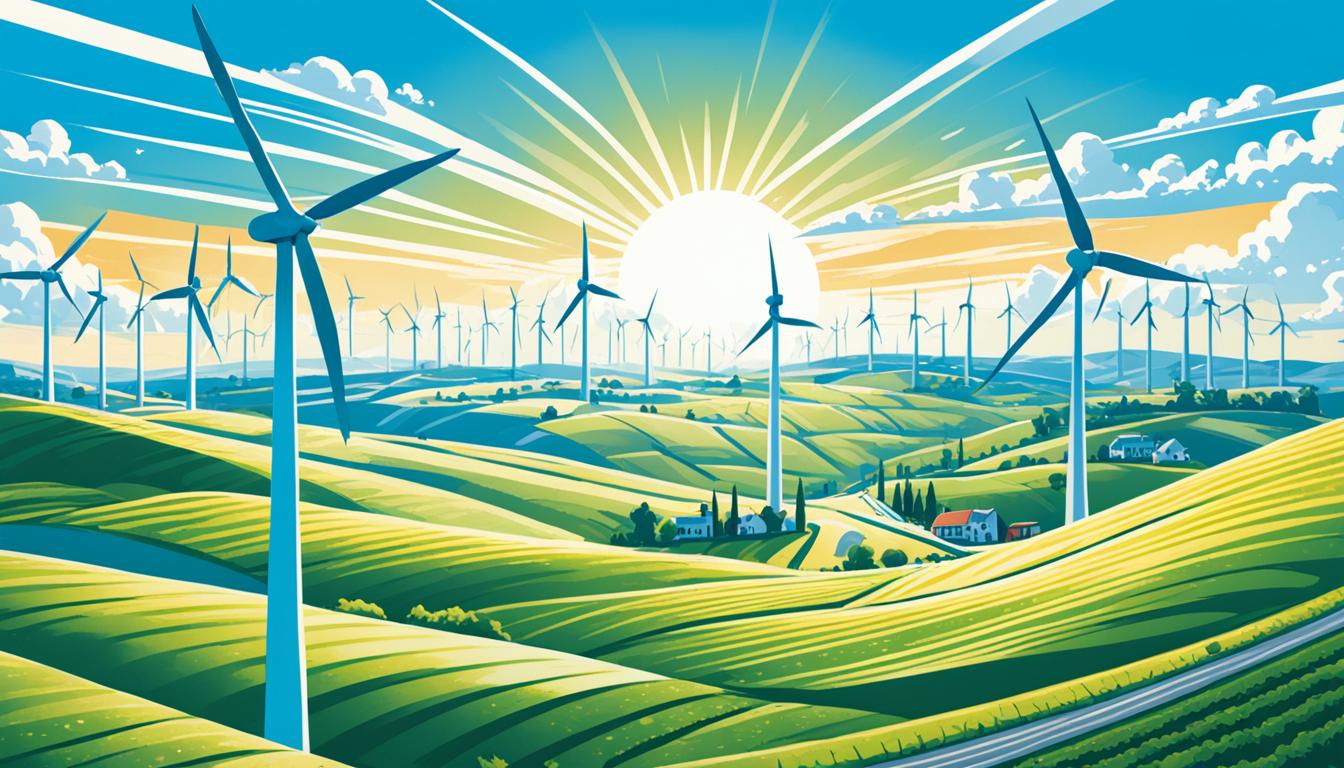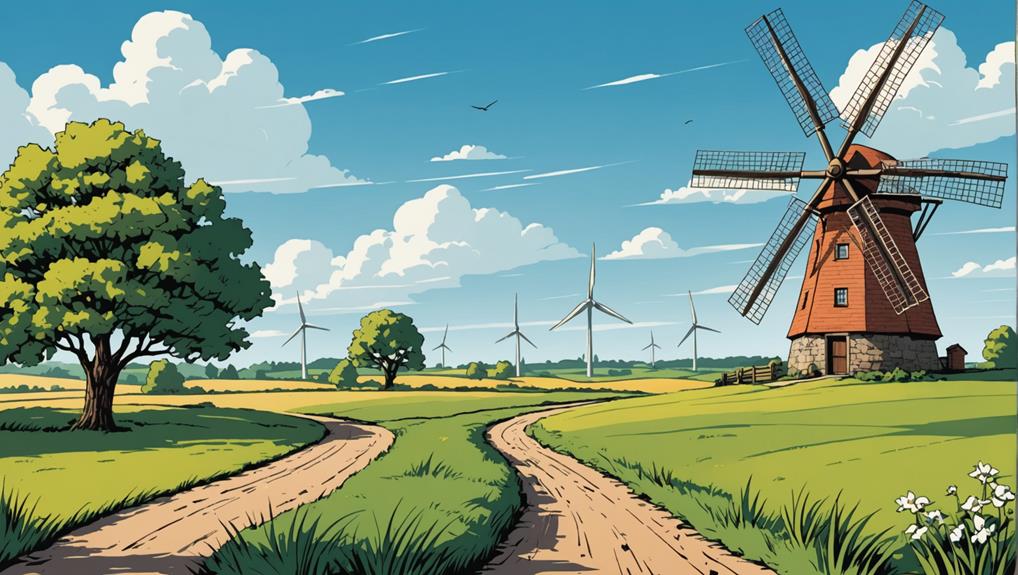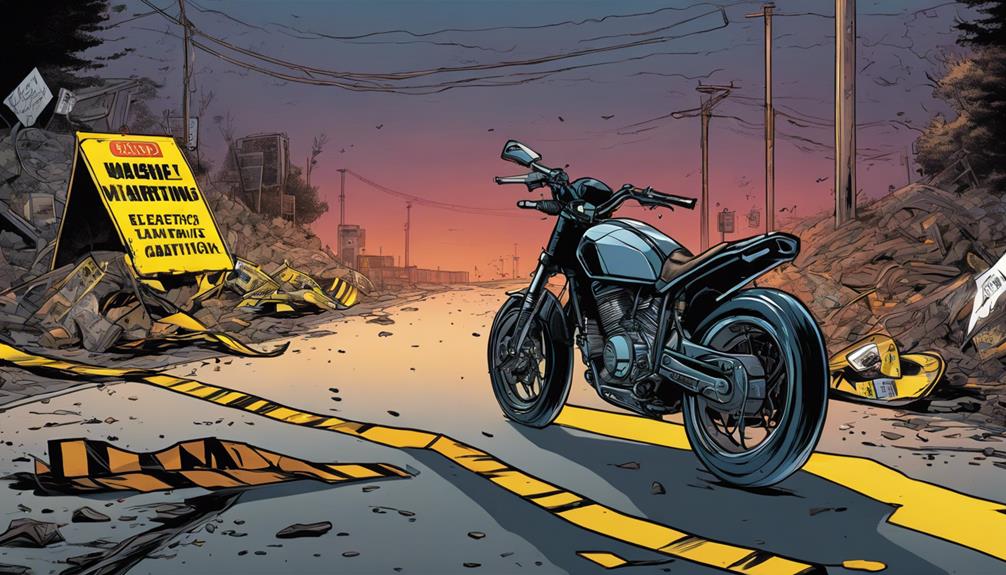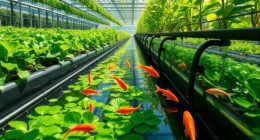Did you know wind turbines generate lots of energy from ocean winds1? These machines play a big part in our shift to renewable energy. Let’s look at how wind turbines work and why they’re so good at their job.
Wind turbines turn wind’s kinetic energy into electrical energy. The wind makes their blades spin. This spin turns into electricity in the generator. The power made depends on wind speed, turbine size, and its efficiency2.
Land-based turbines vary in size from 100 kilowatts to several megawatts1. They can be as tall as skyscrapers with blades over 170 feet long. These blades catch a lot of wind energy3. Offshore turbines are even taller than the Statue of Liberty1. Their big size and placement in windy seas make them great at making electricity.
There are smaller wind turbines for homes, farms, and small businesses. These smaller ones usually make less than 100 kilowatts. They’re chosen for meeting local power needs1.
Wind turbines come as horizontal-axis types with three blades and vertical-axis types, like the eggbeater-style Darrieus1. Each type is best for certain wind conditions and places.
Turbines start working when the wind hits 7-11 miles per hour. They work best at around 27 mph2. But they stop at wind speeds of 55-65 mph to avoid damage3. This auto stop helps them last longer.
Today’s wind turbines are stronger and more efficient. They have direct-drive systems that make generating parts work better and last longer. They avoid gearbox problems3. Also, brakes stop the rotor when the turbine is off3.
Wind turbines help fight climate change by lowering gas emissions2. They don’t harm many birds, especially compared to other dangers like cats and buildings. People work together to protect birds from turbines2.
Now we know how wind turbines work and why they’re key to clean energy. Next, we’ll explore how they operate and their uses in more detail.
Key Takeaways:
- Wind turbines capture the kinetic energy of the wind and convert it into electrical energy.
- Land-based wind turbines range in size from 100 kilowatts to several megawatts, while offshore turbines tend to be taller than the Statue of Liberty.
- Wind turbines start operating at wind speeds of around 7-11 mph and reach maximum output at approximately 27 mph.
- Modern turbines feature direct-drive systems for increased efficiency and reliability.
- Wind turbines have a relatively small impact on bird populations and contribute to reducing greenhouse gas emissions.
The Mechanism Behind Wind Turbines
Wind turbines are high-tech devices. They turn wind into electricity. To understand how they work, we must know their components. These include rotor blades, a generator, and the force of the wind. Rotor blades are the most visible part of a wind turbine. They are designed to capture the kinetic energy of the wind and convert it into rotational energy. This rotational energy is then transferred to the generator, where it is turned into electricity. Understanding how wind turbines work is essential for harnessing the power of renewable energy sources and reducing our dependence on fossil fuels.
The rotor blades are key to catching wind energy. They’re designed to be sleek and efficient. When wind pushes against these blades, they spin. This spinning comes from the wind’s force working with the blades’ shape.
Next, we have the generator, which is linked to the rotor blades. It converts the spinning motion into electrical power. This generator makes Alternating Current (AC) electricity. This electricity powers homes, businesses, and more.
Wind turbines come in different types. There are Horizontal-Axis and Vertical-Axis turbines. Most large-scale turbines use a horizontal axis and have three blades. But, vertical-axis turbines work differently. They can catch wind from any direction because their blades spin on a vertical axis.
Wind turbines work best within certain wind speeds4.They start at speeds of 12-25 kilometers per hour. But they stop if wind speeds exceed 88 kilometers per hour. This prevents damage.
Many parts of a turbine work together to keep it efficient. Pitch control systems adjust the blades’ angle for the best power output. Yaw mechanisms turn the turbine’s top part. This keeps the blades in the best position to catch the wind.
The electricity from wind turbines has many uses. It can power places directly. Or it can be sold to the power network. Sometimes, it’s stored in batteries for later use. This makes our energy supply greener and more reliable.
In summary, wind turbines mix engineering with nature’s force. They use rotor blades, generators, and wind to make clean energy. These turbines are essential for moving toward renewable energy sources.
- Wind turbines start operating at about 12-25 kilometers per hour.
- Wind turbines are not designed to operate above 88 kilometers per hour to prevent damage.
- Turbine blades in modern turbines are sleek and aerodynamically designed.
- Large-scale wind turbines typically rotate at 20 revolutions per minute.
- Domestic-sized turbines revolve at roughly 400 revolutions per minute.
- Gearboxes in large-scale turbines increase rotational speed to 1200-1800 revolutions per minute. The gearbox accomplishes this by connecting gears with different numbers of teeth.
- The generator in wind turbines produces Alternating Current (AC) electricity. Some turbines convert AC electricity to Direct Current (DC) using a rectifier and back to AC with an inverter.
- Pitch control systems alter blade angles to optimize power output.
- Yaw mechanisms turn the nacelle to keep the rotor perpendicular to the wind direction.
- Wind turbine electricity can be used on-site, sold back to the Distribution Network Operator (DNO), or stored in batteries.
Types of Wind Turbines
There are two main kinds of wind turbines: horizontal-axis wind turbines (HAWTs) and vertical-axis wind turbines (VAWTs). Each type stands out for its unique features and uses. They meet different needs in the renewable energy world.
Horizontal-Axis Wind Turbines (HAWTs)
HAWTs are the most seen wind turbine type, making up almost all wind turbines5. They’re known for their three-bladed design. They turn to face the wind. HAWTs range from 1 kW to over 10 MW in power6. They work for both tiny home setups and large wind farms6.
These turbines are huge, as tall as skyscrapers, with blades longer than a basketball court5. Their efficiency and popularity have made HAWTs the top option for producing wind energy worldwide. In 2022, they made up over 97.3% of all wind power6.
Vertical-Axis Wind Turbines (VAWTs)
VAWTs are less common and not as powerful as HAWTs5. They can work no matter which way the wind blows, like the eggbeater-shaped Darrieus model5. Their power ranges from a few hundred watts to several megawatts6. Though not as widespread, VAWTs are still being investigated for their possibilities.
Comparison of Horizontal-Axis and Vertical-Axis Wind Turbines
| Aspect | Horizontal-Axis Wind Turbines (HAWTs) | Vertical-Axis Wind Turbines (VAWTs) |
|---|---|---|
| Design | Three-blade design | Eggbeater-style or other designs |
| Performance | Higher performance | Lower performance |
| Wind-direction flexibility | Adjusts to face the wind | Operates in any wind direction |
| Typical size | Tall, up to 20-story buildings | Taller versions up to 100 feet |
| Common usage | Most common type globally | Less commonly used |
Even though HAWTs lead in wind power, the quest to better both turbine types goes on. Efforts are underway to reduce their impact on wildlife, including techniques to warn birds and bats7. Also, there’s work on making turbine blades lighter, longer, and more efficient at generating power7.
Applications of Wind Turbines
Wind turbines are used both on land and offshore. They offer a green and flexible energy source.
Land-based Wind Turbines
Land-based turbines vary in size and power. They supply large amounts of electricity to the grid. Found in windy places like coasts or steppes, these farms harness the wind8.
Offshore Wind Turbines
Offshore turbines stand in the ocean. They catch stronger winds than those on land. Because of this, they are highly efficient and surpass land turbines in productivity8. Coastal areas benefit from the clean energy they produce.
Distributed Wind
Distributed wind systems are placed where electricity is used. They power homes, farms, and small businesses directly. They often integrate with other renewable sources to provide energy9.
Wind turbines have diverse uses, like producing electricity or pumping water. They play a big role in a clean energy future8.
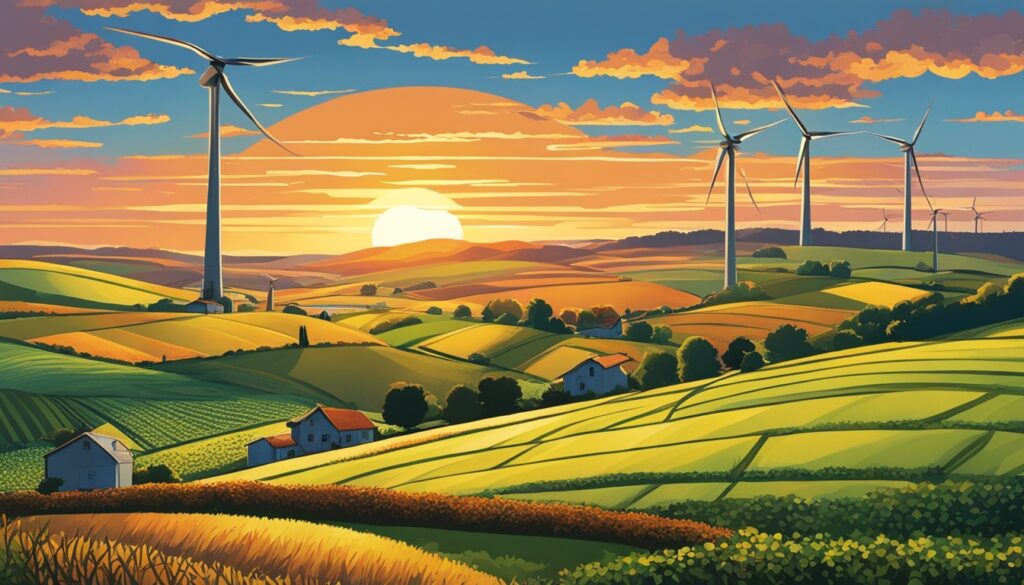
Repsol’s Renewable Energy Projects
Repsol is a key player in renewables across the globe. In Spain, Delta 2 will serve 800,000 homes, cutting 2.6 million tons of CO2 yearly8. The U.S. sees Repsol joining Hecate Energy, with projects over 40 GW, including solar and storage8. A deal in Chile with Grupo Ibereólica could yield over 2,600 MW by 20308.
Benefits and Considerations
Wind power is clean and sustainable. It cuts down CO2 emissions and impacts the environment less. This energy brings economic advantages like cheaper electricity and job opportunities8. Despite its benefits, the impact on wildlife and social acceptance poses challenges. Efforts focus on reducing these issues9.
We must understand wind turbines’ roles and advantages. This will help us embrace wind energy for a more sustainable future.
Wind Turbine Operation
Wind turbines turn wind into electricity, which is then sent out to be used. This section talks about how wind turbines connect to the grid. It also explains how important transformers are in this process.
The wind turbine changes wind into electric power. The electricity goes through a transformer to match the voltage of the national electricity system10. This step is key for efficient power transmission. By raising the voltage, electricity can travel far without losing much energy. This makes wind power more effective.
After bumping up the voltage, the electricity can go to the National Grid transmission network. It can also power homes or businesses directly10. This lets wind-generated electricity reach many people. It provides clean, sustainable energy to homes, schools, and hospitals.
Wind turbines are often in windy places, like open landscapes. This is where they can make the most electricity10. They’re usually white or grey to blend in with the environment. This minimizes their impact on the view.
Wind turbines are designed to catch wind well. They have tall towers to tap into stronger winds up high10. This design helps them capture more wind, making more electricity. This helps grow renewable energy in the country.
Most wind turbines have three blades on a steel tower10. This common design captures wind well and is sturdy. Some turbines have two blades or are made of concrete or steel lattice10. These options work in different places and conditions.
Turbines can spin their blades very fast, up to 1,800 times a minute10. This fast spinning turns a lot of wind into electricity. It’s a key part of making wind power work well.
Between 2006 and 2012, wind turbines operated at over 32% capacity on average10. This means they’re reliable and consistent at making electricity. Wind turbines prove to be a dependable source of power.
Wind energy is cheaper now than it used to be10. It’s one of the most affordable types of electricity. In windy places, the cost of wind energy dropped from 55 cents per kilowatt-hour in 1980 to under 6 cents/kWh10. This price drop makes wind energy a great option for many people.
To see how wind energy costs compare:
| Energy Resource | Average Cost per kWh (cents) |
|---|---|
| Hydroelectric | 2-5 |
| Nuclear | 3-4 |
| Coal | 4-5 |
| Natural Gas | 4-5 |
| Wind | 4-10 |
| Geothermal | 5-8 |
| Biomass | 8-12 |
| Hydrogen Fuel Cell | 10-15 |
| Solar | 15-32 |
Putting in wind turbines can cost a bit, depending on the project size. A small system for a home could be $5,000 to $80,000. A big turbine might cost up to $1.5 million11. Wind farms need about $1,000 per kW of capacity11. So, a farm with seven huge turbines could be around $12.6 million11.
Wind turbines help the environment too. Offshore wind farms, in the ocean, cut carbon dioxide by 99% compared to coal power12. They fight climate change and reduce harmful gases. Plus, they help meet our growing need for electricity.

Summary
Operating wind turbines involves hooking up the produced electricity to the grid with transformers. These transformers make sure the power matches the national electricity system. We often see wind turbines in windy parts of the US. Their big towers and spinning blades capture the wind. Wind turbines mainly use three blades and a steel tower. Thanks to falling costs, wind power is now an affordable electricity source. Wind turbines are also good for the planet. Offshore farms, for example, produce very little carbon dioxide.
Wind Turbine Strength and Efficiency
Efficiency is key when using wind power. Understanding wind turbines’ strength and efficiency is a must. This includes looking at wind speed, design, and how much power they produce.
Wind turbines work best between 7mph and 56mph. But they reach their top efficiency at about 18mph. The highest power is at 27mph13.
Over time, wind turbines have become more efficient. This has helped wind electricity generation grow. In 2022, wind turbines supplied about 10.3% of the U.S.’s electricity13.
A wind turbine’s efficiency is its ability to turn wind into mechanical energy. They are typically 20% to 40% efficient14.
The turbine’s size and design also impact its efficiency. Sizes vary widely, from small residential ones to those over 5 Megawatts for big utilities14.
To get the most power and reduce interference, turbines are placed far apart. They sit at four times their rotor’s diameter from each other. This placement boosts their efficiency and performance15.
Wind power is evolving, with research aimed at making it better, cheaper, and less harmful to the environment. As the world turns more to wind power, governments and businesses are investing more in it. This is leading to better efficiency and a greener future15.
Wind Turbine Strength and Efficiency Statistical Data:
| Data | Source |
|---|---|
| Over 125,000 people are employed in the U.S. wind industry across all 50 stares, with wind turbine service technicians being the advent job of the decade. | Link 1 |
| Wind turbines operating in all 50 states generated over 10% of the total energy in the U.S. in 2022. | Link 1 |
| Wind turbines are typically 20% to 40% efficient at converting wind into energy. | Link 2 |
| The size range of individual wind turbines can vary considerably, from a few kilowatts (kW) for residential applications to over 5 Megawatts (MW) for large scale utilities. | Link 2 |
| Between the cut-in speed and the rated speed, the power output will increase cubically with wind speed. For example, if wind speed doubles, the power output will increase 8 times. | Link 3 |
| Turbines are typically spaced out at four times the rotor diameter to maximize power output and avoid interference between turbines. | Link 3 |

Environment and Wildlife Considerations
Wind energy projects help provide affordable electricity, cut down greenhouse gas emissions, and support energy independence16. But it’s vital to also think about how wildlife, like birds and bats, is affected. Doing this helps us develop sustainably and lessen environmental harm.
Research shows that wind turbines can be dangerous for birds, especially songbirds during migration stops17. Raptors, like red-tailed hawks and golden eagles, are also at risk near these turbines17. To tackle this issue, developers use different methods to keep wildlife safe.
“Wind energy projects can have negative impacts on wildlife and the environment.”
Developers of land-based wind farms use radar, thermal cameras, and ultrasonic devices to watch for wildlife16. They pause work if they find animals nearby during sensitive times like mating season16. This approach helps avoid disturbing or harming them.
To make wind facilities safer for birds and bats, operators monitor these animals’ presence and behaviors closely16. They might stop turbine operations temporarily and use technology to deter the animals, reducing risks16. The GenEst tool by the U.S. Geological Survey helps estimate and manage these risks at wind sites16.
Efforts to lessen wind energy’s environmental impact aren’t just local. They include work with organizations and countries worldwide to find and apply solutions that protect wildlife and their homes16.
The concerns about wind turbines aren’t just on land. Offshore wind energy is growing, with projects in the Atlantic Ocean and plans for others in the Pacific, Gulf of Mexico, Gulf of Maine, and the Great Lakes18. Researchers and managers are working to reduce the chances that flying wildlife will run into wind turbines offshore, aiming to lower displacement and death risks18.
| Statistic | Description |
|---|---|
| Number of Wind Turbines | There are currently more than 73,000 wind turbines in operation across 43 states and territories in the U.S., with most located on land18. |
| Expansion into Offshore Environments | Wind energy production is expanding into offshore environments, with wind facilities present in the Atlantic Ocean and plans for facilities in the Pacific Ocean, Gulf of Mexico, Gulf of Maine, and the Great Lakes18. |
| Risks to Flying Wildlife | Flying wildlife face risks from wind turbines, leading to potential negative impacts such as displacement and mortality18. |
| Mitigation Efforts | Scientists and natural resource managers actively work to mitigate interactions between wildlife and wind turbines to reduce negative impacts18. |
| Addressing Climate Change | The growth of renewable energy, like wind energy production, is crucial in addressing climate change and the increasing need for sustainable energy sources18. |
Finding a balance between using wind energy and protecting wildlife and habitats is key. Continued teamwork, research, and monitoring will help create wind energy projects that are kind to the planet16.

Historical Milestones in Wind Energy
Wind energy’s journey began thousands of years ago. Its first use can be pinpointed to 5,000 BC for sailing boats on the Nile19. By the 11th century, windmills and pumps in the Middle East were aiding food production19. The late 19th century, however, saw groundbreaking advancements in wind turbines.
Professor James Blyth built the first electricity-generating wind turbine in Scotland in 188720. This was a major step forward. Soon after, Poul la Cour invented another electricity-generating turbine in Denmark in 189120. Both events were pivotal for modern wind energy.
In the early 20th century, Denmark excelled in wind power. By 1900, the country had 2,500 windmills generating up to 30 megawatts20. By 1908, Denmark operated 72 electrical wind power systems20. This highlighted wind energy’s growing importance.
The opening of Jacobs Wind in Minneapolis in 1927 marked another milestone20. It produced wind turbines for farms. 1931 saw the creation of both Darrieus and horizontal-axis wind turbines20. These designs are similar to what’s used today.
The first megawatt-size wind turbine was set up in Vermont in 194120. World War II showed wind power’s potential by powering German U-boats20. By 1957, Jacobs Wind had created 30,000 turbines20.
The oil shortages of the 1970s revived interest in wind energy. NASA’s wind turbine program in 1975 led to utility-scale wind turbines20. That year, the first US wind farm was established20.
The late 1970s introduced the world’s first multi-megawatt turbine in Denmark20. The US’s Public Utility Regulatory Policies Act mandated grid interconnection for renewable systems20. These steps greatly promoted wind energy.
China became the top wind electricity producer due to massive investments21. In Europe and the US, financial incentives spurred wind energy growth21. Policies and investments increased turbine installations.
Today, wind energy is vital in the fight against climate change. It could reduce 12.3 gigatonnes of greenhouse gases by 205019. It also promises over 600,000 US green jobs. Wind power is pivotal for a sustainable future.

Conclusion
Using wind turbines to capture wind energy has many positives for a green future. This type of energy is clean, not adding any harmful gases to the air. All around us, wind is plentiful which means we can make lots of energy22. Thanks to better technology and larger production, wind energy is also getting cheaper22.
Putting up wind turbines doesn’t just look after the planet. It also creates jobs in making, putting up, and looking after these turbines22. But, using wind to make power isn’t perfect. There are some problems like how it doesn’t always blow, how turbines look, the noise they make, and getting the power to where it’s needed22. We need to think carefully about where turbines go and talk to communities to solve these issues22. Even with these problems, wind energy is expected to grow because technology is getting better, it costs less, and governments are supporting it22.
Wind energy turns the wind into power with turbines and blades that spin. It cuts down pollution and fights against climate change. This helps the planet and our economy22. Companies like Vestas, GE, and Siemens Gamesa use different stuff to make blades, like fiberglass, carbon, and wood23. The kind of generators they pick also matters for how well they work and how much they cost23.
